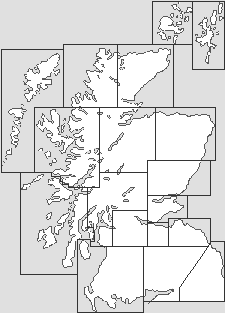 Kintore Town House |
Kintore is a town lying on the south-west bank of the River Don about 12 miles north-west of Aberdeen and three miles south-east of Inverurie. Since 1996 it has been by-passed by the A96 trunk road which provides a dual carriageway connection back to Aberdeen, and according to some sources it is the fastest growing town in Aberdeenshire: a remarkable statistic given the pace with which many of Aberdeenshire's settlements are growing.
The heart of today's Kintore, as it has been for not far short of three centuries, is the Town House. This was completed in 1747, having been paid for by the John Keith, the 3rd Earl of Kintore, when he was elected Provost of the town. The most striking features are the clock-tower and the curved stairs.
The Town House was built in what had previously been the market place. As well as having a council room, the building also held a schoolroom and a store for the agricultural produce of tenants who paid their rent in kind. No spare corner was wasted: when originally built, the space under the stairs formed the burgh gaol.
Amongst the collection of attractive grey stone buildings that make up the town centre, a number of others also date back a considerable period. Goosecroft House, not far from the Town House, was built in 1784, while the Gothic-styled parish church designed by Archibald Simpson arrived on the scene in 1819, roughly the same time as the Kintore Arms Hotel opposite. Some of the cottages in the centre of Kintore are also quite old, including one whose gable, overlooking the churchyard, carries a mounted penny-farthing cycle, presumably as decoration.
Kintore has ancient origins. The name probably comes from the Gaelic Ceann-an-torr, which translates as "the end of a hill". If correct, this must signify Tuach Hill, which rises to a modest 267ft just to the south of the town.
Amongst the early visitors who left their mark here were Roman legionaries. At nearby Deers' Den are the remains of a Roman fort covering 120 acres and large enough to house 10,000 troops. Recent excavations uncovered no fewer than 44 bread ovens. The camp has produced evidence of up to 20 separate buildings and was physically almost as large as modern Kintore itself, while being displaced a little to the west of it. Almost incidentally, the work done to unearth the Roman remains at Kintore has shown that large scale settlement took place here almost continuously from the Bronze age onwards.
It is less clear what was happening in Kintore in the centuries after the Romans departed. It seems unlikely that the Picts who inhabited much of Aberdeenshire in the dark ages ignored the potential of a fertile area which had been so obvious to so many generations of their ancestors. But this mysterious people did leave some traces of their time here. The gateway of the churchyard in the centre of Kintore forms a war memorial. Just inside it is the Kintore Churchyard Stone, a Pictish symbol stone dating back to the early 600s.
The stone carries carvings on both sides, though the style of the carving is different on the two faces and it is thought that the work was done by two different artists and possibly at different times. The side facing the wall surrounding the churchyard carries a carving of a triple disc crossed by a bar, which some have interpreted as a cooking pot hanging above a fire viewed from above. Above it is the detailed carving of a salmon. The reverse side carries poorer carvings of common Pictish patterns described as "V-rod, crescent and beast". The V-rod has been interpreted as a broken arrow, and the "beast" may be a stylised dolphin.
It is typical of the fate of many Pictish stones that this one was discovered being reused as a grave cover in the churchyard. No-one knows where it was originally found, though it may have been associated with three further Pictish stones found elsewhere in Kintore. These have since made their way into museums. Another faint trace of the Picts, though this time of their passing, comes from the story that Kintore was granted its charter as a Royal Burgh in about 840 by Kenneth I for its assistance in his defeat of the Picts.
In 1805 the Aberdeen Canal from Aberdeen to Port Elphinstone, near Inverurie, opened for business. Although it passed through Kintore it had little impact on the town. Of more significance was the replacement of the canal by a railway in 1854: this was a literal replacement, with much of the railway being built along the line of the filled-in canal. Kintore acquired a station and a branch line was later built from here to Alford. The branch line closed in 1950, and Kintore lost its station (though not its railway line) in 1966. Perhaps not surprisingly, given the scale of recent development in Kintore and the importance of its links to Aberdeen, there are plans to build a new railway station in the town on the site of the old.
 The Centre of Kintore |

|
|
|
Visitor InformationView Location on MapWhat3Words Location: ///spends.deep.conceals |
 Kintore Arms Hotel |
 Kintore Parish Church |
 Modern Flats |
 Kintore Public Hall |
 Cottages |
 Goosecroft House |





